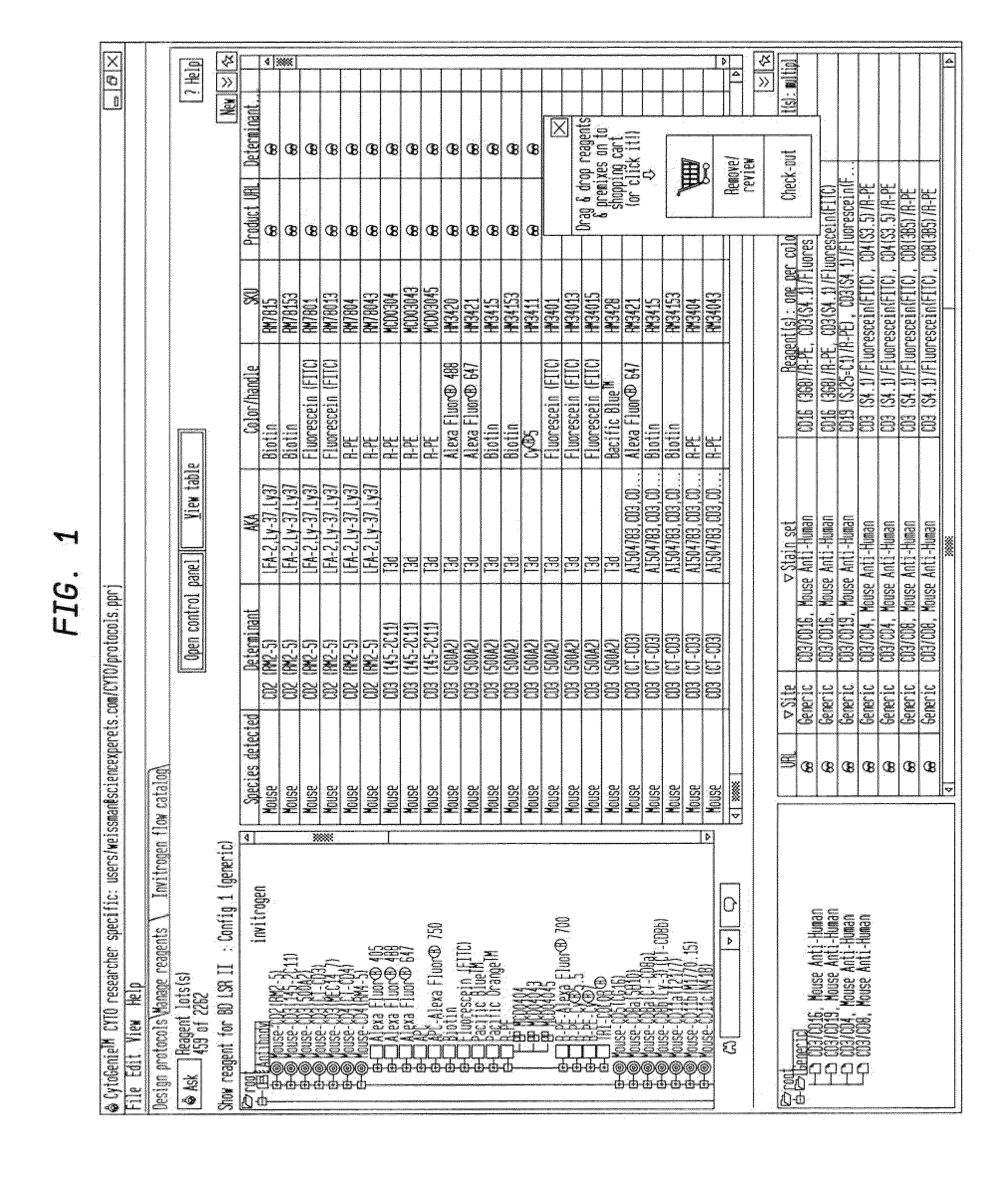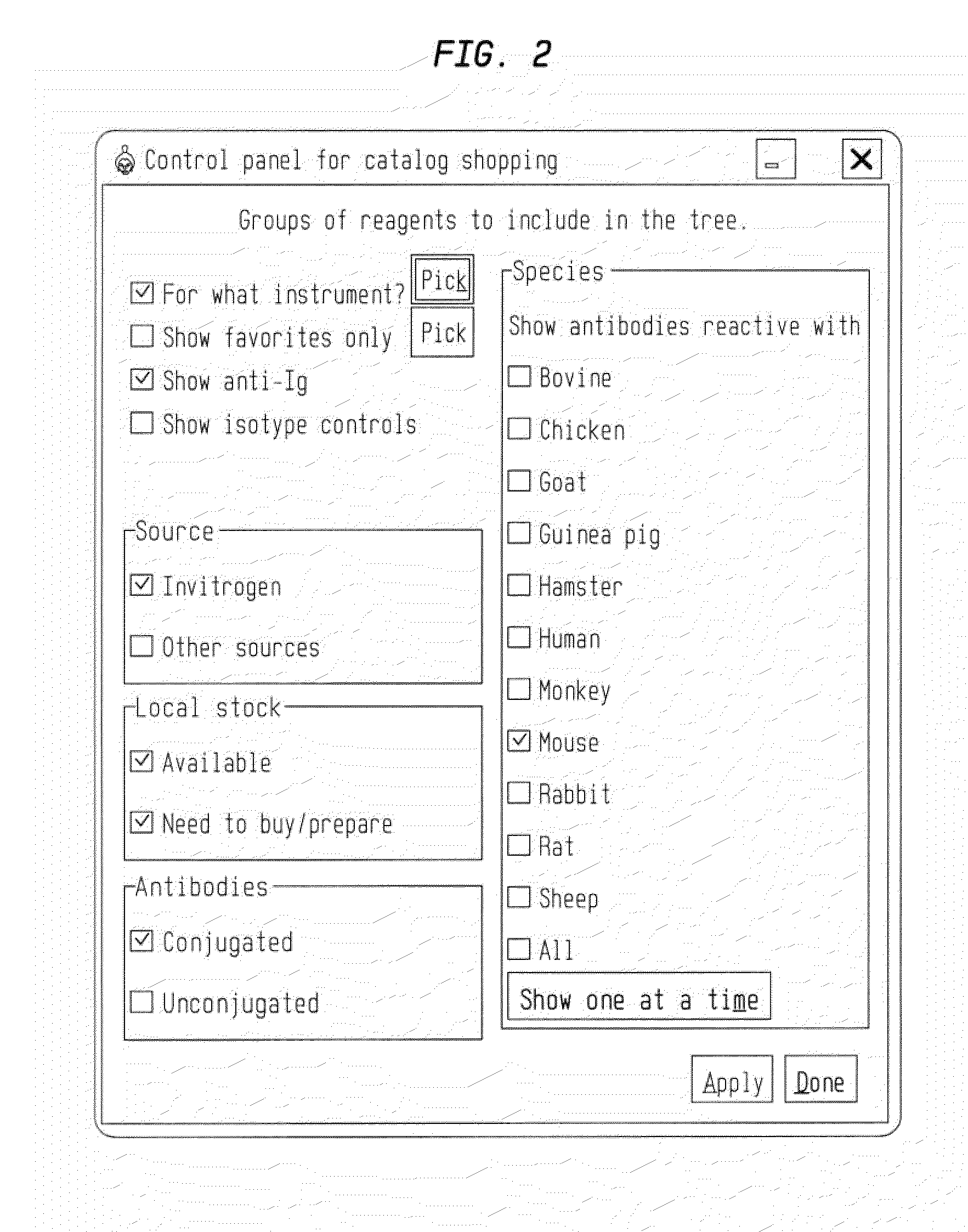System and method for selecting a multiparameter reagent combination and for automated fluorescence compensation
a multi-parameter reagent and automatic technology, applied in the field of flow cytometry, can solve the problems of less efficient excitation at wavelengths, reduced intensity of emitted fluorescence, and inhomogeneous wavelengths, and achieve the effect of rapid design or modification
- Summary
- Abstract
- Description
- Claims
- Application Information
AI Technical Summary
Benefits of technology
Problems solved by technology
Method used
Image
Examples
example 1
Estimation of Fluorescence Compensation
[0341]For an initial fitting of the model to compensation control data, outliers were removed and a linear least squares criterion was applied to select the best fit spectral overlap value for each secondary measurement relative to each primary dye signal. The outliers removed were those with offscale measurements in any fluorescence channel, and events with fluorescence less than two standard deviations above the mean of unstained cells.
[0342]Table 1 shows that for a four-color set of compensation controls, the conventional hand gating for the compensation analysis in FlowJo and the model fitting method of the invention provided similar spectral overlap matrices, especially when considering that the least squares evaluation used in the fitting is likely to be affected by small numbers of events that are well outside the main population.
TABLE 1FlowJo Hand GatingModel FittingFL-A (100%)11.7%2.32%0.30% (100%)11.8%2.33%0.27%PE-A2.27% (100%)22.8%2....
example 2
Evaluating Photoelectron Scaling Using Single Stain Samples
[0347]The variation of data values around the fit line for a particular control sample viewed in the primary dye measurement dimension versus a spectral overlap dimension (see FIG. 8, left panels) derives from the Poisson distributed values in each data dimension based on the signal levels of the data events and the photoelectron scaling in each dimension. The effective variation in the secondary dimension is a composite of the Poisson scale effects in both measurement dimensions, and the details depend on the distribution of data events along the primary axis. Except in the case of measurements on particles with very uniform dye content, the separate photoelectron scales for the two measurement dimensions cannot be estimated separately using data from a single sample. However, in cases where two dyes have substantial spectral overlap each way (as illustrated in FIG. 8), an estimate of both photoelectron scales can be derive...
example 3
Reference Methods for Photoelectron Estimation
[0352]In typical flow cytometry, the accuracy of each fluorescence measurement fundamentally is limited by the uncertainty due to the finite number of photoelectrons generated at the PMT cathode. If a repeated measurement on highly uniform cells or particles resulted in a mean of N photoelectrons, it would be expected that the actual measurements follow a Poisson distribution for mean N in which the standard deviation equals the square root of N. In its simplest form, uniform light pulses with a suitable pulse shape, usually produced with a light-emitting diode (LED), are presented to a cytometer's fluorescence detectors, and the distribution of measured signals is analyzed. The coefficient-of-variation (CV) equal to (standard deviation) / (mean) often is used to characterize such distributions, and the photoelectron estimate is just 1 / CV2. Thus, a distribution with a mean signal of 1000 units and a standard deviation of 100 units would ha...
PUM
 Login to View More
Login to View More Abstract
Description
Claims
Application Information
 Login to View More
Login to View More - R&D
- Intellectual Property
- Life Sciences
- Materials
- Tech Scout
- Unparalleled Data Quality
- Higher Quality Content
- 60% Fewer Hallucinations
Browse by: Latest US Patents, China's latest patents, Technical Efficacy Thesaurus, Application Domain, Technology Topic, Popular Technical Reports.
© 2025 PatSnap. All rights reserved.Legal|Privacy policy|Modern Slavery Act Transparency Statement|Sitemap|About US| Contact US: help@patsnap.com



